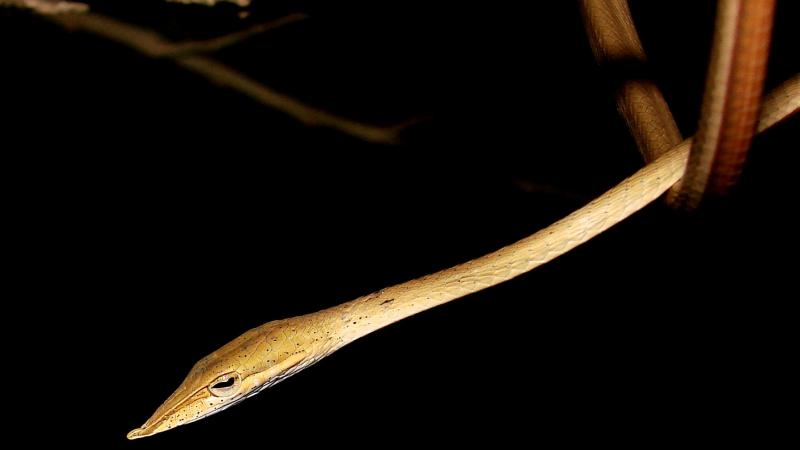
Almost a decade ago, in 2009, two herpetologists spotted a snake crossing the road in the Similipal Biosphere Reserve, Odisha. Although Prof Sushil K. Dutta and Dr Pratyush Mohapatra could tell that they were seeing this snake for the first time in Odisha, little did they know that they were on the verge of a discovery.
"We thought it was another subspecies of the Common vine snake at the time", recollects Dr Mohapatra. Later that year, they spotted a male on a Lantana bush in a sparsely forested area.
Fast forward ten years, that snake has now been identified as a new species and named Ahaetulla laudankia. This discovery of a vine snake species comes after a gap of 113 years, since Annandale described Ahaetulla anomala or the variable colored vine snake in 1906!
In a recent study, researchers from the Natural History Museum, London, Wildlife Institute of India, Nature, Environment and Wildlife Society, Wayanad Wild, and the Zoological Survey of India have described a new species of vine snake from Odisha. The study was published in the Journal of Natural History.
Vine snakes, called so because they closely resemble vines, are rear-fanged, venomous snakes that belong to the family Colubridae. They have a slender body, narrow head and pointed snout. Their remarkable eyes have pupils that look like horizontal keyholes. These snakes are masters of camouflage and blend into their surroundings, waiting for an unsuspecting lizard, frog or bird. Typically, these snakes are either green or grey-brown in colour, with the former inhabiting rainforests, while the latter lives in the savannas or dry forests.
The new species, Ahaetulla laudankia, is an arboreal, chestnut brown snake with black speckles. It resembles the dried stem of a bottle gourd plant, which gives it the name ‘laudankia’, in Odia it translates to the same (lau—bottle gourd; danka—dry stem). This snake is subtle white under its head and has a bright orange-brick red belly with whitish lines running down the length of its abdomen. While the keyhole-shaped iris is black coloured, the outer sclera is usually bicoloured and matches the colour of the snake's head.

Image: A. laudankia or a vine? Credit: Pratyush P Mohapatra
The researchers estimate that A. laudankia is widely distributed across the Eastern Ghats, Central India, extending up until the eastern reaches of Rajasthan. However, despite this wide range, this species has been eluding researchers for almost a decade with only three specimens acquired over the past nine years. In comparison to the other vine snake species, like the variable coloured vine snake (Ahaetulla anomala) and the green vine snake (Ahaetulla nasuta), the researchers say that this species is scarce.
“The population of A. laudankia is most probably quite low, and it might just be naturally rare”, says Dr Mohapatra, who is now working as a scientist at the Zoological Survey of India. Very often, once a species has been discovered, additional information sprouts up from different localities. “Now, apart from Odisha, Maharashtra and Rajasthan, we’ve gathered more information about its distribution in Madhya Pradesh and North Bengal'', he adds.
The new species of vine snake is endemic to India, living in the hilly forests and plains at an altitude of 80-400 meters. The three specimens that the researchers collected in Odisha were from fringe forests near woodlands, full of deciduous trees. Since different species of vine snakes look very similar, the researchers speculate that A. laudankia may have been misidentified in the past. For instance, it may have been mistaken for the variable coloured vine snake, which comes in a plethora of patterns. The researchers emphasise that further studies, which involve collecting new specimens from areas where the variable coloured vine snake are commonly found, can help ensure that A. laudankia is no longer inaccurately identified.
In recent years, many new species of amphibians and reptiles are being discovered across India. So what does this tell us? “Frequent discoveries of higher vertebrates, like reptiles and amphibians, clearly indicate that our knowledge about the actual diversity of these vertebrates is still inadequate in the poorly studied regions of Peninsular India. With the aid of molecular tools, researchers are now trying their best to describe new species with an integrative approach by combining both molecular and conventional morphological taxonomic studies”, concludes Prof Dutta.
Editor's Note: This article was edited to correct an error. The error is regretted.
This article has been run past the researchers, whose work is covered, to ensure accuracy.





